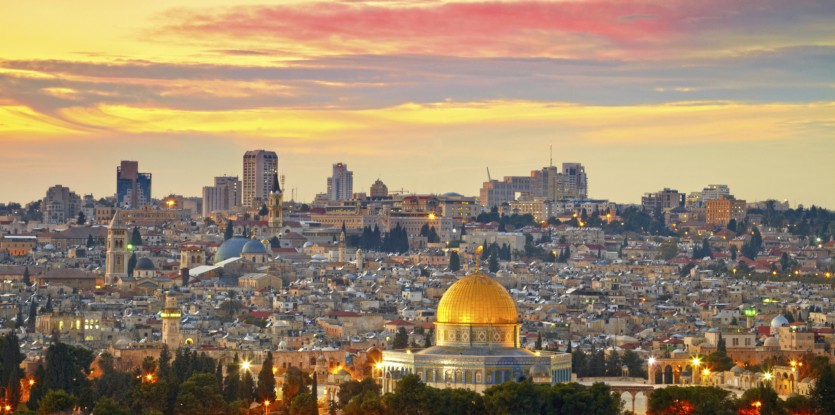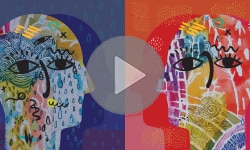Jerusalem Diary
What Happened as the Flames Rose?
Tuesday, August 5, Tisha B’Av, Jerusalem, overlooking the Temple Mount:
I am standing on a rooftop in the Rovah (the Jewish Quarter) in the Old City of Jerusalem, staring at the Temple Mount, mesmerized by the entire scene. To my right I see the mountains where Abraham raised his eyes and gazed at Mt. Moriah (Genesis 22:4). Spanning the horizon from right to left I see the plains of Jericho, across the east bank of the River Jordan, where the Jewish nation crossed into in the Promised Land. Right ahead of me is the Mt. of Olives. And finally, to my left is the Temple Mount.
I mean, does it get better than that? Is there a place on Earth that has more history?
Awe is the only word I can use looking at this scene.
This only confirms my feeling that there is no better place to be now than in Israel. Nothing is closer to reality than standing at the Western Wall on Tisha B’Av, when both Holy Temples were destroyed (thousands of years ago), and rockets are being launched on Israeli cities (in 2014)…
Memories flood me. I was 14 years old the first time I visited the Wall on Tisha B’Av. I was told that on that sad night a white gentle dove appears on top of the Wall and sheds a tear for all that has transpired. I searched for that dove and that tear back then in 1971 and searched for it again last night.
I stand quietly weeping as I stare at the Wall. Broken, scarred, standing alone for over 20 centuries, these barren stones bear witness to all the battles and tragedies that have taken place here throughout history. How much pain and suffering have these enduring stones absorbed? How has the Wall survived it all?
But then a faint smile appears on my face: The fortitude of the Wall also bears witness to eternity. To all the pivotal events that took place at this very spot: The creation of the world began from the Foundation Stone at the peak of the mountain. Adam, the first human, was created here. Abraham’s binding of Isaac and Jacob’s dream all happened here. And then of course, years later, the Holy Temples with the Holy of Holies – where the Divine was revealed on Earth – stood here. All these world changing events are also contained in the Wall’s hidden crevices, as the holiness of this space never leaves… What lessons, I wonder, can the Temple Mount teach us today?”
Our sages tell us (Jerusalem Talmud Berachot 2:4. Midrash Rabba Eicha 1:51) that Moshiach was born as the flames consuming the Holy Temple rose to their highest Tisha B’Av afternoon! What is the significance of this bizarre paradox? Why is the greatest event in history – personal and global redemption – birthed in the darkest moment? And what can we derive from this regarding the present battles in Israel and in our lives?
As I continue to stare at the desolate Temple Mount, the answer, ironically, begins to emerge from this very spot.
The Talmud tells us (end of Tractate Makot) that Rabbi Akiva laughed while his colleagues rent their garments and cried as they witnessed the desolate Temple Mount, where foxes roamed after its destruction. What did Rabbi Akiva see that the other sages did not?
Two forces shape our lives: Pain and pleasure. Though they ostensibly seem like diametric opposites, in truth they are two sides of one coin – two steps in the same life journey. Our myopic, narrow vision – especially when we are still immature and unseasoned – only allows us to see our experiences piece by disjointed piece. In truth, however, a bird’s eye view of the entire horizon – usually seen by people who have matured through suffering – renders all these pieces into frames of one picture, like a story which can only be understood in retrospect after reading the entire book, not just a chapter or two.
Rabbi Akiva – a man who came from a world of darkness: he was ignorant of Torah the first 40 years of his life; he was a son of converts or a convert himself – due to his challenges, gained a perspective that only comes from hard earned, harsh life experiences. This allowed him to transcend a barren mountain and a destroyed Temple and see the future being born in the belly of the beast.
People who have healed through suffering, grown through loss, become empowered through deprivation, have developed a new lens to see growth where others see an abyss.
These are the thoughts flowing through me at the original “ground zero” – here at the holiest place on earth, on the saddest day in history.
The broken Wall, with all its cracks and wounds, silently carries immortality.
Events in Israel today also carry these two visions: Do we see dark shadows, or do we see the light at the end of the tunnel? Do we serve merely as firefighters extinguishing the latest fire, short-term Band-Aids dealing with symptoms, or will we have the courage and strength – and vision – to solve the problem at its root?
And the dove? I am certain that the dove does indeed appear atop the wall. I am also certain that it sheds a tear, but also a smile. However, we need the right set of eyes – the eyes of Rabbi Akiva – to see this bird of peace.
View Rabbi Jacobson’s latest class broadcast Tisha B’Av afternoon overlooking the Temple Mount.








This is so beautiful and such a wonderful way to look at it!